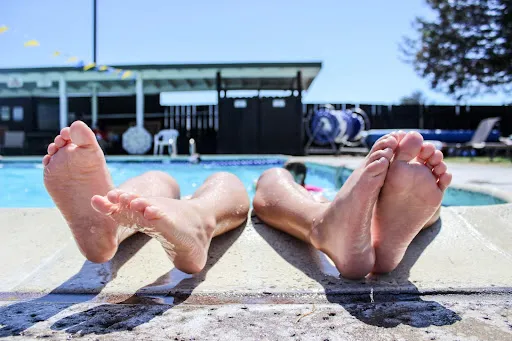In most cases, cracked heels can be treated at home with the right professional foot care products. So don’t put up with heel cracks making it uncomfortable to walk and making you feel self-conscious and hesitant to show off your feet in open-backed shoes or when going barefoot. It’s important to address this issue and find effective remedies for treating and preventing cracked heels.
The objective of this blog is to explore the causes of heel cracks and provide you with practical and efficient ways to get rid of them. By understanding the underlying factors contributing to cracked heels, you can take preventive measures and adopt appropriate treatment methods to restore the health and smoothness of your heels and feet.
In the following sections, we will delve into the various causes of cracked heels and explore home remedies that focus on removing hard, dead skin and leaving skin hydrated and moisturised as the primary treatment methods for heel fissures. So, let’s dive in and discover how to get rid of heel cracks so that you can go swimming, walk on the beach, get your feet out in yoga, and feel confident when your bare feet or heels are on display.
Table of Contents
What are Heel Fissures?
Cracked heels, also known as heel fissures, are a common problem that affects many people. When the skin on the bottom and heels of the feet becomes dry, hard, flaky or crusty, cracks begin to form, leading to discomfort and potential complications. These cracks can be painful, itchy, and may bleed.
Because a heel crack is literally an open wound, infection can also occur in some severe cases. If you are diabetic, it is critical to seek help from your healthcare provider or GP for heel cracks before using home foot care treatments.
Three Causes of Cracked Heels
-
Medical Conditions
Conditions like psoriasis, eczema, fungal infections, Sjogren’s syndrome, palmoplantar keratoderma, diabetes, and hypothyroidism can contribute to cracked heels. When there are any signs of another skin condition or skin infection, such as warmth, redness, or an unpleasant odour, seek medical advice.
There may be an infection present which could require treatment with antibiotics. Additionally, if you have an underlying health issue, it’s essential to consult a doctor, as you may need to adjust your daily routines or take medication.
Lifestyle
Your lifestyle can increase the likelihood of suffering from heel cracks. If you do a job that requires prolonged standing or a lot of physical activities or swimming, your skin can become dehydrated, and this can lead to dry and cracked heels. Walking around bare feet on a daily basis can also contribute to cracked heels as well as dry skin and calluses.
Heat and UV Rays
Have you ever noticed you get cracked heels more in summer? There are a few reasons for this; one is that you may be wearing open-backed shoes or flip-flops. Every time you go out, you expose your skin to heat and UV rays, which can cause damage and quickly dry out skin resulting in heel cracks.
Best Ways to Get Rid of Cracked Heels
Heel cracks are more difficult to treat than calluses or corns. When they are deep, you should avoid using foot files or pumice stones as they may cause more damage and will increase the risk of developing an infection. But if you tackle them as soon as you notice them, with effective home foot care treatments, you can get rid of heel cracks.
Hydrate and Moisturise: Using a good quality intensive moisturiser or heel balm containing humectants, occlusives, or emollients can help to hydrate and soften skin. Not only can regular use of these products help to heal cracks, but they can also help to prevent them from reoccurring.
Foot Soak and Exfoliation: Soaking feet in lukewarm water and salt can reduce the chance of an infection. Following a ten-minute soak, the skin will be softer, and it is easier to carefully use a pumice stone or foot file to remove dead, thick skin. But be careful not to overdo it and remove too much skin.
Wearing Cotton Socks to Bed: Heel cracks that show no signs of infection may heal faster if you wear cotton socks after moisturising you’re feet. This is especially worthwhile when you go to bed because wearing cotton socks will give the active ingredients a chance to soak in completely.
Foot Care Regime: The best way to treat and prevent heel cracks is to incorporate a regular foot care regime into your week. In a busy world, our feet are often the last thing we pay attention to — until they start to hurt or we feel embarrassed of them.
Simply using a foot file or foot peel to remove dead skin once a week should be enough to stop it from building up. Another easy thing you can do is moisturise your feet after a bath or shower and before you go to bed. The latest foot peels are also an effective way to gently remove dead skin, calluses, and corns and prevent heel cracks from reoccurring.
Take Away
Your feet are precious and deserve your care and attention. After all, don’t you deserve to feel confident about every part of your body? Taking the time to look after your feet and keep them in tip-top condition is just basic self-care!
















